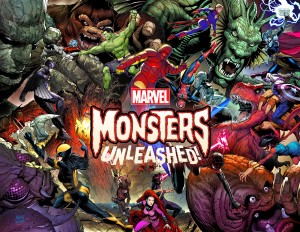
 Monsters Unleashed #1 (of 5) — Writer: Cullen Bunn; Pencils: Steve McNiven; Inks: Jay Leisten; Colors: David Curiel
Monsters Unleashed #1 (of 5) — Writer: Cullen Bunn; Pencils: Steve McNiven; Inks: Jay Leisten; Colors: David Curiel
The Mighty Captain Marvel #1 — Writer: Margaret Stohl; Art: Ramon Rosanas; Colors: Michael Garland
Let’s start with the two Marvel debuts: Monsters Unleashed is a tribute to all those pre-superhero monster stories that the company was pumping out in the late ’50s and early ‘60s, before Fantastic Four #1 ushered in the Marvel Age. Most had standard-issue cheesy plots by Stan Lee, involving alien invasions or mankind messing with things better left alone, but the art, by the likes of Jack Kirby and Steve Ditko, was energetic and imaginative, and Stan’s story 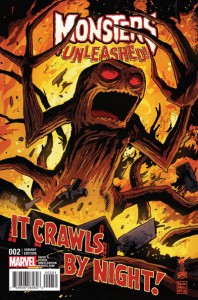 twists work OK, as long as you don’t read too many of them at once; most of those concepts have faded into history, although a couple of them — Fin Fang Foom, who’s still around (and featured prominently on the cover of this first issue) and, of course, Groot — have become part of the mainstream Marvel universe. This mini-series is supposed to be a tribute to that era, although the familiar old creatures don’t show up until the last page; instead, Earth is being bombarded by other monsters, larger and more Lovecraftian, with tentacles and eyeballs and beaks everywhere, crashing down from space and wreaking havoc. Most of this issue involves a series of splash pages of various groups — the Avengers, the X-Men, the Black Panther, the Guardians of the Galaxy, the Inhumans and the Champions, especially — fighting the invasion in different
twists work OK, as long as you don’t read too many of them at once; most of those concepts have faded into history, although a couple of them — Fin Fang Foom, who’s still around (and featured prominently on the cover of this first issue) and, of course, Groot — have become part of the mainstream Marvel universe. This mini-series is supposed to be a tribute to that era, although the familiar old creatures don’t show up until the last page; instead, Earth is being bombarded by other monsters, larger and more Lovecraftian, with tentacles and eyeballs and beaks everywhere, crashing down from space and wreaking havoc. Most of this issue involves a series of splash pages of various groups — the Avengers, the X-Men, the Black Panther, the Guardians of the Galaxy, the Inhumans and the Champions, especially — fighting the invasion in different 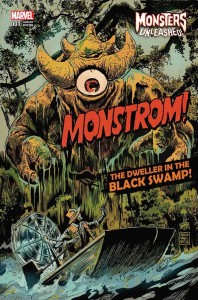 locales (and, not incidentally, setting up crossover books focusing on some of the specific fights), while, separately, Moon Girl and Elsa Bloodstone hunt for answers. Steve McNiven’s a good choice for artist — he has a standard, detailed superhero style that’s up to the dozens and dozens of characters he ’s required to present — and, especially if you have a soft spot for those pulpy, sixty-year-old original tales, this is worth a look. There are some tie-in books, too, but at least Marvel’s numbering them as stand-alone “1.MU” issues, so they won’t mess up the regular continuity; points too for making this mini-series bi-weekly, so we won’t have to wait until summer to get a resolution (assuming, of course, that it all comes out on time…). The Mighty Captain Marvel, while a relaunch, takes up right after Civil War II and is pretty much just like the Captain’s previous
locales (and, not incidentally, setting up crossover books focusing on some of the specific fights), while, separately, Moon Girl and Elsa Bloodstone hunt for answers. Steve McNiven’s a good choice for artist — he has a standard, detailed superhero style that’s up to the dozens and dozens of characters he ’s required to present — and, especially if you have a soft spot for those pulpy, sixty-year-old original tales, this is worth a look. There are some tie-in books, too, but at least Marvel’s numbering them as stand-alone “1.MU” issues, so they won’t mess up the regular continuity; points too for making this mini-series bi-weekly, so we won’t have to wait until summer to get a resolution (assuming, of course, that it all comes out on time…). The Mighty Captain Marvel, while a relaunch, takes up right after Civil War II and is pretty much just like the Captain’s previous  two series — although the writer, Margaret Stool, is new; she’s probably best known for co-writing the YA series Beautiful Creatures. She presents a Captain who’s still leading Alpha Flight, dealing with a flood of alien refugees who are fleeing a looming galactic menace and trying to find sanctuary on Earth, but ending up in settlement camps and facing serious prejudice from the locals; any similarity to current immigrant problems on our own Earth is, presumably, intended. That connection gives the story some heft, and the art, which looks much like Carol’s appearance in her last volume, is clear and competent; the whole package should be attractive to previous fans of the character, and might even convince a couple of new ones, too.
two series — although the writer, Margaret Stool, is new; she’s probably best known for co-writing the YA series Beautiful Creatures. She presents a Captain who’s still leading Alpha Flight, dealing with a flood of alien refugees who are fleeing a looming galactic menace and trying to find sanctuary on Earth, but ending up in settlement camps and facing serious prejudice from the locals; any similarity to current immigrant problems on our own Earth is, presumably, intended. That connection gives the story some heft, and the art, which looks much like Carol’s appearance in her last volume, is clear and competent; the whole package should be attractive to previous fans of the character, and might even convince a couple of new ones, too.
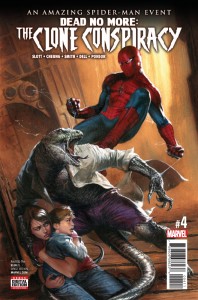 The Clone Conspiracy #4 (of 5) — Writer: Dan Slott; Pencils: Jim Cheung; Inks: John Dell and Cory Smith; Colors: Justin Ponsor
The Clone Conspiracy #4 (of 5) — Writer: Dan Slott; Pencils: Jim Cheung; Inks: John Dell and Cory Smith; Colors: Justin Ponsor
Amazing Spider-Man #23 — Writers: Dan Slott and Christos Gage; Pencils: Giuseppe Camuncoli; Inks: Cam Smith; Colors: Jason Keith
Spider-Gwen #16 — Writer: Jason Latour; Art: Robbi Rodriguez; Colors: Rico Renzi
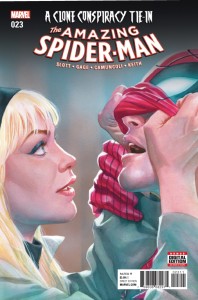 Three spider-books this week, with Clone Conspiracy and Amazing very closely connected (if you’re getting them both, Clone Conspiracy should be read first, although they’re sort of running on parallel tracks), with the Jackal’s plan to revive all the people in Spidey’s life who’ve died (along with lots of others) threatening to turn into a zombie apocalypse. As he demonstrated in Spider-Verse, author Slott is good at these multi-part, continuity-rich extravaganzas, and there are enough twists, turns and Easter eggs for long-time readers to keep everyone
Three spider-books this week, with Clone Conspiracy and Amazing very closely connected (if you’re getting them both, Clone Conspiracy should be read first, although they’re sort of running on parallel tracks), with the Jackal’s plan to revive all the people in Spidey’s life who’ve died (along with lots of others) threatening to turn into a zombie apocalypse. As he demonstrated in Spider-Verse, author Slott is good at these multi-part, continuity-rich extravaganzas, and there are enough twists, turns and Easter eggs for long-time readers to keep everyone 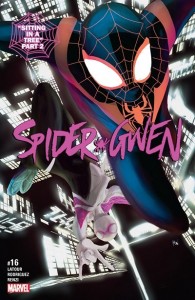 happy (Clone Conspiracy has a scene between the newly-revived Dr. Octopus and Anna Marie that fans of Superior Spider-Man will want to see, while Amazing has a Peter/Gwen Stacy/Captain Stacy one that even older fans will appreciate). Spider-Gwen is a crossover with the Miles Morales Spider-Man, coming out of the last issue of that title and leading into the next one, as Miles has shown up in Gwen’s alternate reality looking for his dimension-tossed father; it’s a decent-enough middle installment of the trilogy, and of course if you’re already reading Spider-Man you’ll want to get it.
happy (Clone Conspiracy has a scene between the newly-revived Dr. Octopus and Anna Marie that fans of Superior Spider-Man will want to see, while Amazing has a Peter/Gwen Stacy/Captain Stacy one that even older fans will appreciate). Spider-Gwen is a crossover with the Miles Morales Spider-Man, coming out of the last issue of that title and leading into the next one, as Miles has shown up in Gwen’s alternate reality looking for his dimension-tossed father; it’s a decent-enough middle installment of the trilogy, and of course if you’re already reading Spider-Man you’ll want to get it.
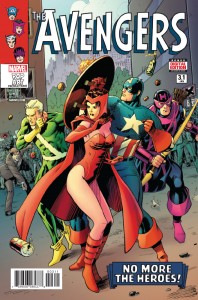 Avengers #3.1 (of 5) — Writer: Mark Waid; Pencils: Barry Kitson; Inks: Mark Farmer with Rafael Fonteriz and Barry Kitson; Colors: Jordan Boyd with Will Quintana
Avengers #3.1 (of 5) — Writer: Mark Waid; Pencils: Barry Kitson; Inks: Mark Farmer with Rafael Fonteriz and Barry Kitson; Colors: Jordan Boyd with Will Quintana
Black Widow #10 — Writers: Chris Samnee and Mark Waid; Art: Chris Samnee; Colors: Matthew Wilson
U.S. Avengers #2 — Writer: Al Ewing; Pencils: Paco Medina; Inks: Juan Vlasco; Colors: Jesus Aburtov
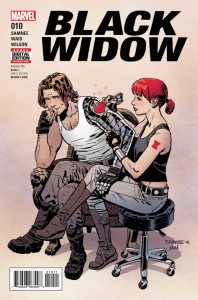 The Ultimates2 #3 — Writer: Al Ewing; Art: Travel Foreman; Colors: Dan Brown
The Ultimates2 #3 — Writer: Al Ewing; Art: Travel Foreman; Colors: Dan Brown
Invincible Iron Man #3 — Writer: Brian Michael Bendis; Art: Stefano Caselli; Colors: Marte Gracia
Hellcat! #14 — Writer: Kate Leth; Art: Brittney L. Williams; Colors: Rachelle Rosenberg
Cage! #4 (of 4) — Writer/Pencils: Genndy Tartakovsky; Inks: Stephen DeStefano; Colors: 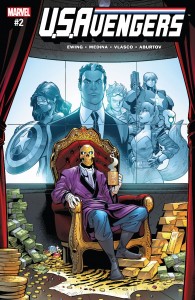 Scott Wills
Scott Wills
All the rest of the Marvels: Avengers 3.1 continues its retconning of the middle-‘60s period around Avengers #16-20, when the new team consisting of Cap, Hawkeye, Scarlet Witch and Quicksilver took over; both Waid and Kitson have done all they can to make this feel like a Silver Age book, from the tone to the art to the “Marvel Pop-Art Productions” cover dress to using the original letters pages from those classic books, and the result is an expanded look at that version of the team and its tensions and  triumphs, and, not incidentally, a lot of fun. U.S. Avengers is the up-to-date version of the team (one of them, anyway), with Roberto de Costa/Sunspot/Citizen V leading Squirrel Girl, Enigma, Iron Patriot and a Red Hulk as they encounter a future-version Captain America and her nemesis, a Golden Skull who, far from being a Nazi, is a very Trumpian corporate pirate and one-percenter who’s trying to take over the world and institute a “global kleptocracy.” None of those heroes are particularly high-profile, but Ewing’s good at this kind of thing, and getting to know the
triumphs, and, not incidentally, a lot of fun. U.S. Avengers is the up-to-date version of the team (one of them, anyway), with Roberto de Costa/Sunspot/Citizen V leading Squirrel Girl, Enigma, Iron Patriot and a Red Hulk as they encounter a future-version Captain America and her nemesis, a Golden Skull who, far from being a Nazi, is a very Trumpian corporate pirate and one-percenter who’s trying to take over the world and institute a “global kleptocracy.” None of those heroes are particularly high-profile, but Ewing’s good at this kind of thing, and getting to know the  players and their interrelationships at this early stage is more than enough to keep superhero fans occupied. Ewing’s also helming Ultimates2, and there he’s going wide-screen cosmic, with a plot involving no less than a recreation of most of the higher powers of the post-Secret Wars Marvel Universe; Galactus is now a lifegiver instead of a destroyer; the Jim Starlin creations of Chaos and Order have murdered the Living Tribunal and merged with the In-Betweener to form a new being, and we haven’t even mentioned the problem with Eternity… if you know those characters, or are intrigued by the sounds of them, then this is the book for you. Invincible Iron Man
players and their interrelationships at this early stage is more than enough to keep superhero fans occupied. Ewing’s also helming Ultimates2, and there he’s going wide-screen cosmic, with a plot involving no less than a recreation of most of the higher powers of the post-Secret Wars Marvel Universe; Galactus is now a lifegiver instead of a destroyer; the Jim Starlin creations of Chaos and Order have murdered the Living Tribunal and merged with the In-Betweener to form a new being, and we haven’t even mentioned the problem with Eternity… if you know those characters, or are intrigued by the sounds of them, then this is the book for you. Invincible Iron Man  continues its own recreation, as an absent Tony Stark has created an AI system that mirrors his own personality (of course he has…), and is now mentoring the 15-year-old mechanical genius, and new possessor of the Iron Man technology, Riri Williams. New-kid-learning-the-ropes plots are always fun, since they give writers a chance to go back to the rookie early years of a character while still keeping the classic parts intact, and Bendis is doing a good job with it here; Caselli does his part by making the newbie suit-wearer appealing and interesting visually, too. Hellcat finishes up a multi-part fight with the Black Cat; it’s still one of Marvel’s better YA-type books, with its brightly-colored,
continues its own recreation, as an absent Tony Stark has created an AI system that mirrors his own personality (of course he has…), and is now mentoring the 15-year-old mechanical genius, and new possessor of the Iron Man technology, Riri Williams. New-kid-learning-the-ropes plots are always fun, since they give writers a chance to go back to the rookie early years of a character while still keeping the classic parts intact, and Bendis is doing a good job with it here; Caselli does his part by making the newbie suit-wearer appealing and interesting visually, too. Hellcat finishes up a multi-part fight with the Black Cat; it’s still one of Marvel’s better YA-type books, with its brightly-colored, 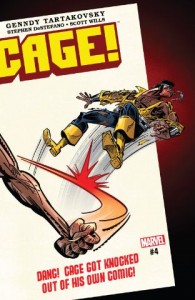 simple manga-ish art and its combination of classic continuity and diversity-friendly modern sensibilities. Black Widow offers Chris Samnee and Mark Waid following the adventures of Natasha Romanov, in this issue teamed up with her sometime-love-interest and friend, Bucky Barnes, as they go to the moon and encounter the post-Fear Itself version of Nick Fury, holding down the Watcher’s old position. That leaves Cage!, which is pretty much exactly what you’d expect from a version of the former Hero for Hire and Power Man done by the creator of Samurai Jack. This issue is mostly one big fight scene, and it’s as exaggerated, dynamic and kinetic as anything this side of Jack Kirby; you really do have to see it to believe it.
simple manga-ish art and its combination of classic continuity and diversity-friendly modern sensibilities. Black Widow offers Chris Samnee and Mark Waid following the adventures of Natasha Romanov, in this issue teamed up with her sometime-love-interest and friend, Bucky Barnes, as they go to the moon and encounter the post-Fear Itself version of Nick Fury, holding down the Watcher’s old position. That leaves Cage!, which is pretty much exactly what you’d expect from a version of the former Hero for Hire and Power Man done by the creator of Samurai Jack. This issue is mostly one big fight scene, and it’s as exaggerated, dynamic and kinetic as anything this side of Jack Kirby; you really do have to see it to believe it.
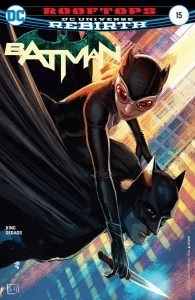 Batman #15 — Writer: Tom King; Art/Colors: Mitch Gerads
Batman #15 — Writer: Tom King; Art/Colors: Mitch Gerads
Justice League vs. Suicide Squad #5 (of 6) — Writer: Joshua Williamson; Pencils: Robson Rocha; Inks: Jay Leister, Daniel Henriques, Sandu Flores and O’cair Albert; Colors: Alex Sinclair with Jeremiah Skipper
Justice League of America: The Ray — Rebirth #1 (of 1) — Writer: Steve Orlando; Art/Colors: Stephen  Byrne
Byrne
Superman #15 — Writers: Peter J. Tomasi and Patrick Gleason; Art: Ryan Sook, Ed Benes, Clay Mann and Jorge JImenez; Colors: Sook, Dinei Ribeiro, Ulises Arreola and Alejandro Sanchez
Cave Carson Has a Cybernetic Eye #4 — Writers: Jon Rivera with Gerard Way; Art: Michael Avon Oeming; Colors: Nick Filardi
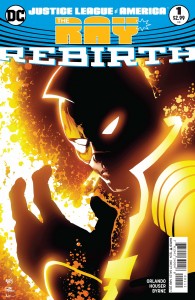 Harley Quinn #12 — Writers: Jimmy Palmiotti and Amanda Conner; Art: John Timms with Chad Hardin; Colors: Hi-Fi
Harley Quinn #12 — Writers: Jimmy Palmiotti and Amanda Conner; Art: John Timms with Chad Hardin; Colors: Hi-Fi
Of the DC books, Batman concludes a two-parter featuring Catwoman, as Selena and Bruce get romantic (very romantic, to the delight of fan-fic writers everywhere), and we find out the real reasons why Selina was in prison, accused of murdering almost 250 people. King does his usual 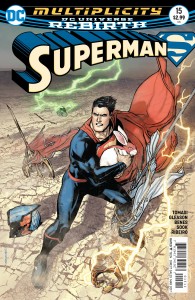 stellar job on the script, and guest artist Gerads is (mostly) a good choice for the rooftop and moonlight-drenched setting — “mostly” because Selina’s face is a little off in the opening-page splash, although the rest of the art is effective. Justice League vs Suicide Squad continues its everybody-but-the-kitchen-sink plot, with the Justice League now bad, the Suicide Squad — both old and new versions — trying to stop them, and things generally deteriorating into lots of flashy punching and
stellar job on the script, and guest artist Gerads is (mostly) a good choice for the rooftop and moonlight-drenched setting — “mostly” because Selina’s face is a little off in the opening-page splash, although the rest of the art is effective. Justice League vs Suicide Squad continues its everybody-but-the-kitchen-sink plot, with the Justice League now bad, the Suicide Squad — both old and new versions — trying to stop them, and things generally deteriorating into lots of flashy punching and 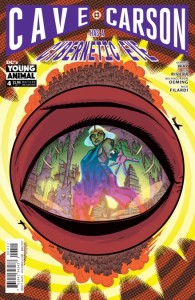 yelling: exactly what we want from a series like this, actually. Justice League of America: The Ray is another one-shot with a new origin for that character; for someone who uses light and darkness as much as he does, the art’s appropriately pyrotechnic and good-looking. Superman continues a new arc involving the multiversal Justice League Incarnate (including the Barack Obama Superman), who are trying to prevent an unknown being from kidnapping or killing various alternate-reality versions of the Man of Steel; fans of Grant Morrison’s Multiversity, or of DC’s various Crisis on
yelling: exactly what we want from a series like this, actually. Justice League of America: The Ray is another one-shot with a new origin for that character; for someone who uses light and darkness as much as he does, the art’s appropriately pyrotechnic and good-looking. Superman continues a new arc involving the multiversal Justice League Incarnate (including the Barack Obama Superman), who are trying to prevent an unknown being from kidnapping or killing various alternate-reality versions of the Man of Steel; fans of Grant Morrison’s Multiversity, or of DC’s various Crisis on 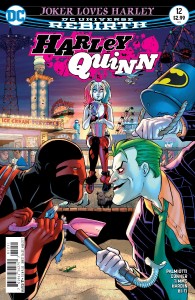 Earth-One, Two Three, etc. stories, should like this a lot. Cave Carson continues its first arc, with underground mysteries and mayhem following Cave, his daughter, and the vigilante Wild Dog as they investigate the destruction of the deep-down kingdom of Muldroog, while fending off the machinations of Cave’s former boss, who’s behind it all and convinced everyone else that the group has turned outlaw; Oeming’s art is perfect for this kind of high-concept, high-energy pulpy fun. Harley Quinn, finally, offers the middle of a three-parter involving the Joker, who’s either sincerely trying to make up with Harley or involved in some insane multi-layered scheme; either way, it doesn’t go well for him — but it’s a good time for readers.
Earth-One, Two Three, etc. stories, should like this a lot. Cave Carson continues its first arc, with underground mysteries and mayhem following Cave, his daughter, and the vigilante Wild Dog as they investigate the destruction of the deep-down kingdom of Muldroog, while fending off the machinations of Cave’s former boss, who’s behind it all and convinced everyone else that the group has turned outlaw; Oeming’s art is perfect for this kind of high-concept, high-energy pulpy fun. Harley Quinn, finally, offers the middle of a three-parter involving the Joker, who’s either sincerely trying to make up with Harley or involved in some insane multi-layered scheme; either way, it doesn’t go well for him — but it’s a good time for readers.
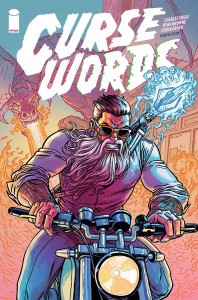 Curse Words #1 — Writer: Charles Soule; Art: Ryan Browne; Colors: Ryan Browne, Jordan Boyd and Michael Parkinson
Curse Words #1 — Writer: Charles Soule; Art: Ryan Browne; Colors: Ryan Browne, Jordan Boyd and Michael Parkinson
The Few #1 — Writer: Sean Lewis; Art: Hayden Sherman
Angel: Season 11 #1 — Writer: Corinna Bechko; Art: Geraldo Borges; Colors: Michelle Madsen
WWE #1 — Writer: Dennis Hopeless; Art: Serg 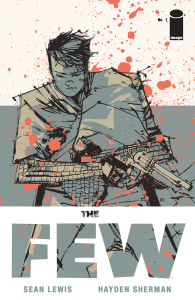 Acuna; Colors: Doug Garbark
Acuna; Colors: Doug Garbark
The indy #1’s: Curse Words is about a wizard in modern-day New York City who’s more than he seems; Soule and Browne offer the opposite of decompressed storytelling, opening even just this first issue into a great big old backstory that makes readers feel like they got their money’s worth. The Few has a great big old backstory too, but spoons it out more slowly, only dropping hints about its 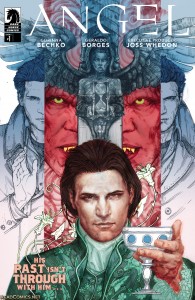 dystopian future US, ruled by some sort of empire in the coastal states and part of the northern border, with small groups of rebels camped out in the sparsely-populated midland. Both should appeal to you if you’re a fan of some of the other creator-owned Image books in the fantasy/sf genres. Angel is the next volume of the adventures of Joss Whedon’s Buffy the Vampire Slayer spinoff about a vampire
dystopian future US, ruled by some sort of empire in the coastal states and part of the northern border, with small groups of rebels camped out in the sparsely-populated midland. Both should appeal to you if you’re a fan of some of the other creator-owned Image books in the fantasy/sf genres. Angel is the next volume of the adventures of Joss Whedon’s Buffy the Vampire Slayer spinoff about a vampire 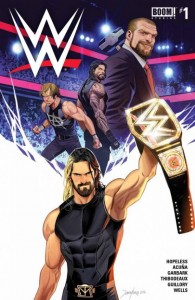 who gets his soul back, and finds that’s not always such a good thing; it’s got its own large cast and backstory, and a decent fan-base too, one that’s been following the character for almost twenty years. This is a good starting place to see why. As for WWE, yes, that stands for World Wrestling Entertainment, and this is a comic about their athletes. When I was fifteen or so, I would have liked this, and when my kids were fifteen they would have too, so if you’re fifteen yourself, or have some fond memories of that age, this book might be for you.
who gets his soul back, and finds that’s not always such a good thing; it’s got its own large cast and backstory, and a decent fan-base too, one that’s been following the character for almost twenty years. This is a good starting place to see why. As for WWE, yes, that stands for World Wrestling Entertainment, and this is a comic about their athletes. When I was fifteen or so, I would have liked this, and when my kids were fifteen they would have too, so if you’re fifteen yourself, or have some fond memories of that age, this book might be for you.
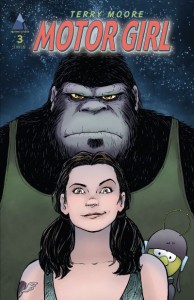 Motor Girl #3 — Creator: Terry Moore
Motor Girl #3 — Creator: Terry Moore
Kill or Be Killed #5 — Writer: Ed Brusker; Art: Sean Phillips; Colors: Elizabeth Breitweiser
Archie #16 — Writer: Mark Waid; Art: Joe Eisma; Colors: Andre Szymanowicz
Motor Girl is Terry Moore’s current series, about a cute mechanic at a junkyard who’s ex-military, and traumatized enough to have an imaginary guardian who’s the Ape to her Angel; complicating matters is 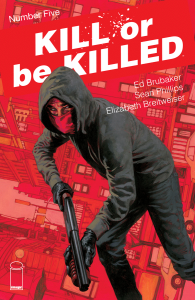 that, out in the southwestern desert where she lives, there are actual little green aliens flying around in saucers whom she’s befriending, but then shady characters are trying to buy the land where it’s happening, and presumably everything will connect up into some of this creator’s trademark action, adventure and humor. Speaking of humor, the “whimsical” dial on the aliens could probably stand to be turned down a notch, but don’t let that put you off: Moore is always, always worth reading. So are Ed Brubaker and Sean Phillips, whose crime comics have the requisite street grit but then go off in unexpected directions; Kill Or Be Killed, their latest project, is about a
that, out in the southwestern desert where she lives, there are actual little green aliens flying around in saucers whom she’s befriending, but then shady characters are trying to buy the land where it’s happening, and presumably everything will connect up into some of this creator’s trademark action, adventure and humor. Speaking of humor, the “whimsical” dial on the aliens could probably stand to be turned down a notch, but don’t let that put you off: Moore is always, always worth reading. So are Ed Brubaker and Sean Phillips, whose crime comics have the requisite street grit but then go off in unexpected directions; Kill Or Be Killed, their latest project, is about a  serial killer who’s compelled to kill someone once a month, and how he tries to find worthy victims (there’s also a demon, but at this point in the story it’s hardly worth mentioning…). Archie gives Mark Waid a three-comic hat trick for the week; it continues his reimagining of the Riverdale cast, although this issue’s Dilton tale would have worked just as well in a ‘60s issue drawn by Dan Decarlo; it’s got both the tight plot and the reasonably-subtle social message of that era, and does a good job of reminding us that there’s not really much of a gap between the older and newer versions of these characters.
serial killer who’s compelled to kill someone once a month, and how he tries to find worthy victims (there’s also a demon, but at this point in the story it’s hardly worth mentioning…). Archie gives Mark Waid a three-comic hat trick for the week; it continues his reimagining of the Riverdale cast, although this issue’s Dilton tale would have worked just as well in a ‘60s issue drawn by Dan Decarlo; it’s got both the tight plot and the reasonably-subtle social message of that era, and does a good job of reminding us that there’s not really much of a gap between the older and newer versions of these characters.



